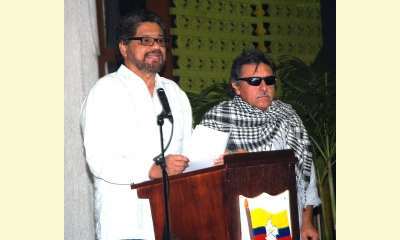|
|
FARC-EP and Colombia Government advance in their peace accords
un article par Prensa Latina
The Colombian insurgency and the Government of the
country announced here today (11 April , Havana)
that they have made progress in the construction of
agreements to resolve the problem of illicit drugs.

click on photo to enlarge
In a joint statement issued this morning at the
closing of the XXIII cycle of peace negotiations,
the Revolutionary Armed Colombia People's Army
(FARC-EP ) and its Government counterpart said
they share views on the final eradication of the
phenomenon.
They affirmed that the solution must be framed
within a Comprehensive Rural Reform, jointly
developed with the participation of communities
concerned, for the design, implementation,
monitoring, control and evaluation of actions.
The parties reiterated the invitation to the
Colombian people to participate with their proposals
to the discussions of the dialogue table which has
been installed in Havana since November 2012.
They furthermore thanked Cuba and Norway, the
countries sponsoring the negotiations; as well as
Chile and Venezuela, who are accompanying the
process, for their constant support during the
talks.
They reported that they will resume work at the
dialogue table on 24 April.
The issue of illicit drugs is the third issue of
their six-point agenda .
The FARC-EP and the Government have already arrived
to partial agreements related to agricultural
development and political participation .
(Click here for a Spanish version of this article)
|








|
DISCUSSION
Question(s) liée(s) à cet article:
What is happening in Colombia, Is peace possible?
* * * * *
Commentaire le plus récent:
The force of non-violence constrains the force of arms!
Colombia - the force of peaceful resistance -
At the beginning of July, the rebels of the armed revolutionary forces of Colombia (FARC) kidnapped a 51 year old Swiss, and his Colombian assistant who worked in the Indian communities of Cauca province where they were setting up development projects by building schools and community production enterprises.
The news of the kidnapping was spread through all the villages and 2000 Indians set out to pursue the 400 guerillas. They reached them at an elevation of over 4000 meters (12,000 feet), encircled them, and without any weapon, constrained them to release the 2 hostages! (After 2 days, the hostages were released).
This release, obtained through "peaceful resistance" has raised a national debate: the possibility of resisting violence without needing to use weapons has demonstrated the effectiveness of human solidarity movements.
"I will return, and I will then be millions" prophesied the Aymara Indian leader Tapak Katari, in 1781, at the time of his execution by the Spanish conquistadors.
100 million in 1492, the Indians were no more than 4,5 million one century and half later. Currently there are 44 million Indians populating Latin America.
In spite of their great diversity, the Indian movements take on more and more importance. In Ecuador, Guatemala, Bolivia, Peru, Mexico or Colombie they are opposed to the neoliberal system that governs the Americas, while protesting against the imposition of the American economic market. . ... continuation.

|
|









